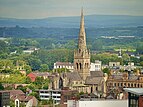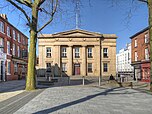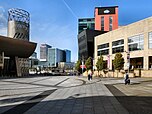
Back سالفورد Arabic سالفورد ARZ Salford AST سالفورد، منچستر بزرق AZB Kota Salford BAN Солфард Byelorussian Солфард BE-X-OLD Солфорд Bulgarian Солфорд CE Salford (kapital sa kondado) CEB
| Salford | |
|---|---|
| City | |
| |
Location within Greater Manchester | |
| Area | 8.1 sq mi (21 km2) |
| Population | 129,794 (2021 Census)[1] |
| • Density | 8,981/sq mi (3,468/km2) |
| Demonym | Salfordian |
| OS grid reference | SJ805985 |
| • London | 164 mi (264 km) SE |
| Metropolitan borough | |
| Metropolitan county | |
| Region | |
| Country | England |
| Sovereign state | United Kingdom |
| City areas in the 2011 UK Census | |
| Post town | SALFORD |
| Postcode district | M3, M5–M7, M50 |
| Dialling code | 0161 |
| Police | Greater Manchester |
| Fire | Greater Manchester |
| Ambulance | North West |
| UK Parliament | |
Salford (/ˈsɒlfərd/ SOL-fərd) is a city in Greater Manchester, England,[2][3] situated on the western bank of the River Irwell which forms its boundary with Manchester city centre. Landmarks in the city include the former town hall, Salford Cathedral, Salford Lads' Club and St Philip's Church. In 2021 it had a population of 129,794. The demonym for people from Salford is Salfordian.
Salford is the main settlement of the wider City of Salford metropolitan borough, which incorporates other towns including Eccles, Pendlebury, Swinton and Walkden. Nearby towns in other metropolitan boroughs include Stretford, Urmston, Bolton, Sale and Bury, Prestwich, and Radcliffe. Salford is represented by the Member of Parliament for the Salford constituency, created in 2023.
Salford was named in the Early Middle Ages, though evidence exists of settlement since Neolithic times. It was the seat of the large Hundred of Salford in the historic county of Lancashire and was granted a market charter in about 1230, which gave it primary cultural and commercial importance in the region.[4] It was eventually overtaken by Manchester during the Industrial Revolution.[5][6] The former County Borough of Salford was granted city status in 1926; the current wider borough was established in 1974.[7]
The economy of the city in the 18th and 19th centuries was focused on a major factory district for cotton and silk spinning and weaving, and as a major inland port after the opening of Salford Docks in 1894. Industrial decline in the 20th century led to the city having run-down and antisocial areas.[8] Salford has been subject to slum clearances and other regeneration programmes since the 1930s. From 2007, multiple media companies set up headquarters at the MediaCityUK development in Salford Quays, an area established in the 1980s on former dockland.[9] Notable organisations based in the city include the University of Salford, Salford City Football Club, Salford Red Devils, BBC North and ITV Granada.
- ^ UK Census (2011). "Local Area Report – Salford (11119884030)". Nomis. Office for National Statistics. Retrieved 23 March 2018.
- ^ Lewis, Stephen (20 February 2016). "Manchester and Salford: so what's the difference?". I Love Manchester. Retrieved 17 January 2023.
- ^ "SALFORD TO BE JOINED WITH MANCHESTER - Salford Star - with attitude & love xxx". www.salfordstar.com. Retrieved 17 January 2023.
- ^ Frangopulo 1977, pp. 135–138.
- ^ Cite error: The named reference
Engels74was invoked but never defined (see the help page). - ^ Salford West Strategic Regeneration Framework and Action Plan (PDF), Salford City Council, December 2006, retrieved 11 November 2007 [dead link]
- ^ UK Census (2011). "Local Area Report – Salford Local Authority (1946157086)". Nomis. Office for National Statistics. Retrieved 23 March 2018.
- ^ Cooper 2005, p. 47.
- ^ "BBC Salford move gets green light", BBC News, 31 May 2007, retrieved 31 May 2007






